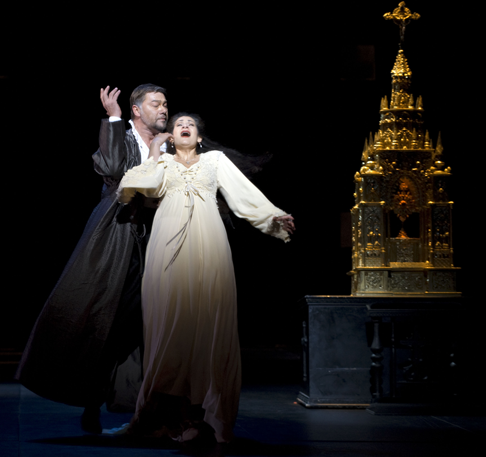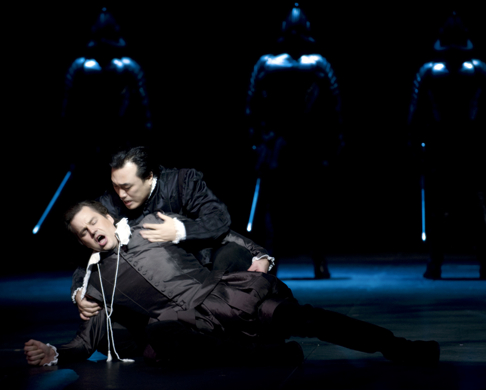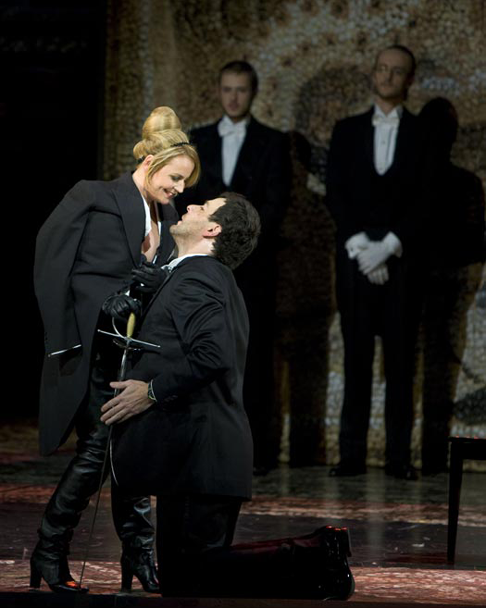My only previous experience with the Norwegian National Opera had
been a number of years ago for a perfectly competent L’Italiana in
Algeria (or was it La Cenerentola?).
While the exact Rossini may be forgettable, what is still vividly
implanted from that visit was that the company was housed, make that
“tucked away” inside a depressingly non-descript shopping arcade,
poorly signed, and with an auditorium of a garden variety 60’s high
school multi-function room. Lo these many intervening years, I always told
myself I would wait to return until they had the long-talked about new
home.
Well, the wait is over, and Godot is here. The brilliant new house is
nothing short of stunning with an imposing, glacier-like facade right on the
water (you can walk up two sloping roofs outside to the top of the lobby!),
sporting exceedingly handsome and spacious public areas (the men’s
plumbing fixtures appear like fountains framed by indirect lighting almost
too pretty to soil!), and a gorgeous and rich dark-wood auditorium with
excellent acoustics. It reminded me of a silhouette of a Viking ship with its
coloring and curving lines.
And they have happily inhabited these auspicious surroundings with a
festival quality production of Don Carlo, being shared with Covent
Garden and the Metropolitan Opera.
The opening forest scene of Bob Crowley’s handsome design looks like
a very elegant, very expensive Hallmark card, with raised white silhouettes
of trees, and a central winding path nestled in perspective between snow
carpets (which might have benefited from a little more tape applied to the
edges). Within this lovely setting director Nicholas Hytner created detailed
staging with the soloists, devising interaction and stage business that not
only conveyed their youthfulness, but also the playfulness of their
courtship.
That directorial inventiveness was in ample supply is witnessed by such
touches at act’s end as having the courtiers laying cloaks in the snow
for the (now) “queen” to cross to a waiting sedan chair to be
lifted high and carried through the crowd with a heart-rending clear sight
line to the devastated Carlo.
This (and subsequent scenes) was framed by a box of walls that were evenly
dotted with small square holes. These openings allowed for terrific lighting
effects from designer Mark Henderson, such as the tomb scene where shafts of
white light spookily slashed through the copious chemical fog on stage. The
ostentatious black marble tomb down left with the lone word
“Carlos” engraved large on it, was tracked to move diagonally
upstage and be separated by walls to create an alcove, allowing the vacated
space for hero and heroine to play out their important confrontation
scene.
 Anja Harteros as Elisabeth and RenÈ Pape as Filip II (Photo courtesy of Den Norske Opera & Ballett)
Anja Harteros as Elisabeth and RenÈ Pape as Filip II (Photo courtesy of Den Norske Opera & Ballett)
The subsequent garden scene was so playful it looked like it could have
come from Crowley’s sketchbook for Elton John’s Broadway
Aida. An expansive field chockful of red flowers was fronted by a
dominating triangular piece of wall made up of large red, well, bricks. .
.sort of. A cut out of a cross frames a dangling crucifix (did I say
“playful”?) and church bell. A long continuous diagonal bench
completed the setting which allowed for an especially animated “Veil
Song” with ladies dancing front, behind, and on the bench thanks to the
choreography of Scarlett Mackmin.
What the setting may have lacked for atmosphere for the love duet, was
more than compensated by superlative blocking that was alternately
impassioned, despairing and sensual. Should the duo be prone on the ground,
as I have never seen before? It sure worked dramatically. And hey, maybe that
is why the King never wants her to be alone! Powerful stuff.
The “other garden” scene of mistaken identities was given a
great assist by layers of scrim panels of trees center and left, and a large
rounded ivied wall right. For once the confusion of shadows and light worked,
with Eboli ducking between scrim and full view, rendering Carlo’s
gullibility of her identity believable. This rounded wall remained (sans ivy)
for the auto-da-fe, with a large ornate alter-piece-as-church-facade
filling the upstage.
This was the best staging of this problematic section that I have yet
seen. The usual dumb show of processing sinners as the (sorry, Giuseppe)
rather indifferent dirge of a march churns along, was here devised as a
last-chance-before-you-fry scenario in which a priest challenges each of six
convicts in turn by name to repent their heresy. Purists may chide me for
enjoying the made up chatter that competes with the music, but damn if it
didn’t make the proceedings come alive.
The rounded wall turned out to be a scrim panel revealing the naked
sinners burning at the stake and, in a brilliant touch, the Heavenly Voice
came from high above the back of auditorium. Doink! What a great solution! It
should never be done any other way! (Especially if you have the silvery tones
of Eli Kristin Hanssveen at your disposal.)
The home stretch was increasingly more spare with the study simple and
sparsely furnished and the cell completely vacant, until we returned to the
tomb. My appreciation for Mr. Hytner continued to grow as he drew motivated
movement, detailed acting, and emotionally varied performances from his
principals. Posa’s death scene, with the anguished Carlo cradling his
cherished friend made me weep for the first time ever. The sometimes
ungrateful final duet scene found Elisabetta and Carlo with ever fresh and
imaginative interaction, at one point sitting together on the steps of the
tomb.
 Keith Ikaia-Purdy as Don Carlo and Peter Mattei as Posa (Photo courtesy of Den Norske Opera & Ballett)
Keith Ikaia-Purdy as Don Carlo and Peter Mattei as Posa (Photo courtesy of Den Norske Opera & Ballett)
Of course, no one (except perhaps a handful of German Regie-Theater
eccentrics) goes to Don Carlo for the scenery. And on the musical
side, this performance could scarcely have been bettered. Conductor Marco
Guidarini drew idiomatic, nuanced playing from the pit, and had a secure
command over the pace and sweep of the masterpiece. While he could sometimes
dawdle and indulge a bit, such as the bridge in “O Don Fatale,”
in general the rhythmic drive was right on the money. While the great duet
for Fillipo and the Inquisitor was as brisk as I have heard, what it lost in
gravity it gained in evil menace.
Rene Pape made a fine Filippo and he voiced a compelling “Ella
giammai m’amo,” although it must be said that he was initially a
little muted, since he usually serves notice with his first utterances that
he is a force to be reckoned with. Local girl Ingebjorg Kosmo made a wholly
successful Eboli. What she may lack in pin-your-ears-back power in the lower
middle, she more than makes up for with a healthily-produced sound and
intelligent artistry. True, she broke up a few climactic phrases so as to
give the most kick possible at the end of “Fatale” but then so do
other successful practitioners. Silvia Moi’s light-voiced Tebaldo
contributed all that was required, and she had a committed and graceful stage
presence.
I would think that Anja Harteros must be rapidly on a track to become the
Elisabetta of choice for the world’s leading houses. She deploys her
dark-hued voice with technical mastery and deeply personalized phrasing,
laden with meaning and gorgeous tone. She can handle the dramatic outbursts
with common sense pacing, and can float a secure pianissimo at will. And it
is no stretch to imagine this beautiful woman as both a queen, and the object
of someone’s romantic attention.
Peter Mattei deployed his mellifluous kavalierbariton to tremendous effect
with a beautifully sung Posa. His tall and lanky presence literally towered
over the rest of the cast, and his acting was simple and affecting. His
emotion-laden prison scene was all that could be wished.
The title role has been a calling card for tenor Keith Ikaia-Purdy all
over the continent (several continents, in fact) and it is easy to see why.
This wonderful artist serves up a richly detailed and nuanced performance, as
capable of full-throated outpourings of pointed sound, as he is at scaling
back to well-crafted mezzo-piano and sotto voce phrases laden with subtext.
His subtlety impresses as much as does his capacity for clarion top notes.
Of course, our hero does get pushed aside in the final act as soloist
after soloist regale us with some of the top four arias/pieces Verdi ever
produced. (After he reappears in the prison scene with Rodrigo, I always sort
of summon up a paraphrased echo of Anna Russell: “Remember Don
Carlo?”). However, Mr. Ikaia-Purdy’s presence and committed
acting immediately recaptured our attention, and Posa’s death was the
most affecting I have ever experienced, not just because Mr. Mattei sang it
uperlatively, but because our Don Carlo cradled the baritone in such
inexpressible grief.
While this Oslo experience was first class and the performance top drawer,
it was to prove to be only the first of three wonderful Scandinavian
evenings.
Somehow, over the years, I have never been in Stockholm during the regular
opera season, having made it to the Drottningholm and Dalhalla festivals, but
not to the lovely and venerable Belle Epoque-style home of the Swedish Royal
Opera. The occasion of this first visit was the premiere of a handsome new
mounting of Samson et Dalila, cast from strength with (as far as I
can tell) regular company members.
 Richard Decker sang the title role as well as anyone probably does these
Richard Decker sang the title role as well as anyone probably does these
days. Think of a more suave and musically refined Cura, and you’ll get
the idea. Mr. Decker’s muscular, baritonal tenor served Samson very
well and he certainly had the requisite beefy high notes, although sometimes
achieved by fudging of the French (the exposed “Je t’aime”
came out “zhah-tah-mah”.) Too, he cuts a handsome enough figure
and his acting was sincere and appropriate.
David Bizic turned in a world-class star performance as the “High
Priest,” his rich bass ringing out with pointed declamation and
astonishing vocal presence. It’s not often this role gets the
lion’s share of applause. The disappointing and woolly Albimelich was
taken by Sten Wahlund, who (although no announcement was made) had to have
been indisposed.
Dalila was engagingly sung by Anna Larsson, who paired her plummy and rich
mezzo with committed acting to great effect. The famous arias were
sumptuously rendered, and the self-righteous pronouncements were filled with
dramatic fire. If her rapid melismas sounded a bit effortful here and there,
this was overall a notable success. A handsome woman,Ms. Larsson was somewhat
hindered by a costume that was too drab, albeit wholly in keeping with the
“concept.”
Director/choreographer Renaud Doucet boldly chose to frame the piece in
modern day Gaza. This allowed for some brilliant opportunities, as well as
some vexing problems. Not least of which is that while Yitzhak Rabin is
lionized, and the Jewish plight is sympathetically heightened, the
necessities of the opera’s plot assignments make the Palestinians come
off very badly. Very very badly. So, while short on diplomacy and balance,
just how did it come off as theatre?
Well. Indeed, very very well. The handsome design by Andre Barbe was
meticulously lit by Guy Simard. The settings were rather like modern
sculpture for people who don’t think they like modern sculpture. We
first see imposingly large, burnished silver metal security walls with bright
(and I mean bright) red rope threaded through it high above the action. Is
the huge knot meant to be the Gordian knot? Is it the rope of fate waiting to
be woven? No matter, it is beautiful as can be, and. . .it allows us to
theorize.
These walls are re-configured for act two creating a “room” of
sorts down left, and a huge coil of the red rope is fashioned into a couch
(with culminating tassel laid to rest beside it), upon which our lovers
consummate their passion before it becomes a barber-chair-by- default. The
walls tighten to create a narrow space center stage in which “Samson at
the mill” is really turning a giant spindle on which a length of red
rope is being wound. Finally, the great hall is framed by pieces of these
walls creating a forced perspective, with a greatly truncated rope is strung
between the upstage receding walls. The set pieces shuddered, bent and
tumbled very effectively in the Climactic Pillar Pull.
The modern dress costumes (also by Mr. Barbe) were appropriate, with
exception of our heroine. Although she had to be in Muslim dress, complete
with head scarf, it did not allow her to be physically alluring, and indeed
her dress entirely argued against that which hampered the obvious sexual
dynamic considerably.
However, most of the stage pictures were gripping, and the visceral
connection with some of the visual imagery was brilliant. The opera started
with a shallow playing space, backed by a scrim. Children are playing with a
soccer ball stage left, a white limo is parked stage right. A couple of
worried mothers hasten their children away when several evil looking goons
approach the car. The thugs leave, the kids return, and then the car
“explodes,” with pieces of it carried through the air in stylized
fashion by the white suited terrorists. We audibly gasped at the horrific
simplicity of this stagecraft.
The Bacchanal was another master stroke. Instead of the usual DeMille
kitsch, Doucet realized it as the occasion for production of a suicide bomber
recruiting film, that got more and more abhorrent as first a woman begs to be
included in the mission (and is allowed), and then a young couple with a very
small child. Compelling theatre. This same film is later shown as video
footage on Dagon News with Dalila and the Priest as fanatical
commentators.
And things were on the same high level in the pit. Conductor Gregor Buehl
led a beautifully judged and stylistically convincing account of this most
atmospheric of scores. He was not only accommodating of his fine soloists,
but elicited clean and dramatically convincing singing from the well-trained
chorus.
It will be a long time before I encounter as gripping and musically
satisfying a Samson et Dalila as this at the Swedish Royal Opera. I
changed gears entirely the following night, encountering a delightful new
production of Handel’s Partenope in Copenhagen at the Danish
Royal Opera. Although this company also has a gorgeous new house for the
larger-scale pieces in the repertoire, they still use the handsome
“old” house for Baroque and chamber operas.
Pride of place for this Partenope has to go to conductor Lars
Ulrik Mortensen and his exceptional instrumentalists. This was without a
doubt the best period instrument performance (and perhaps Handel performance)
I have yet heard. To me, this music can sometimes just churn on and on,
albeit very pleasantly. But here was a reading with a consistent dramatic
tension, an electrifying propulsion, a flawless sense of melodic line, and
creatively varied dramatic accents, not least of which were the oft magical
“buttons” at the end of set pieces. Magical, that is indeed the
word.
The Royal Opera assembled uncommonly fine soloists all, with the star hype
being reserved for counter-tenor Andreas Scholl. This debut performance as
Arsace was only his third opera role. To get the bad news out of the way, Mr.
Scholl was announced as “greatly indisposed” but, in the interest
of the premiere, he was going to go on and do his best. And his considerable
“best” was, well, quite good enough.
Although he vocally marked his recitatives, he did not stint one whit in
his acting and physical business. From photos, I had expected him to be
short, bespectacled, and bookish, but sans glasses, he was tall, dark, and
handsome. And like Juan Diego Florez, he has excellent comic acting
abilities. He was highly affecting in his famous plaintive arias. A total
professional, his committed and brave performance was not only enjoyable, it
made me want to hear him again when he is well. It was quite evident that Mr.
Scholl is a special artist.
The rest of the company was not only healthy, but fabulous. French
counter-tenor Christophe Dumaux (Armindo) showed off an unusually bright and
focused tone, and was wholly impressive in his solid technique, pleasing
demeanor, and fearless physical acting. At opera’s start, I though that
Inger Dam-Jensen’s “Partenope” might be a little diffuse in
tone for the role’s demands, but in a matter minutes — wow
— she sounded like Renee at her most ravishing, with awesome rapid-fire
coloratura and superb musicianship. Her spoiled sex kitten approach slowly
matured to create the evening’s most detailed and fully realized
character.
Company member Tuva Semmingsen’s securely voiced Rosmira was solidly
on a quality level of many of the world’s better known (and probably,
paid) mezzos. On the basis of this assured outing, Ms. Semmingsen
emphatically has the agility, burnished tone, stylistic command, and star
presence to join their ranks. She is short, wiry, fiery, and delectable.
In the smaller role (vocally, if not in stage time) of Ormonte, Palle
Knudsen first appeared scampering on stage from the prompter’s box, and
proceeded to surprise and delight us the whole night, at one point rappelling
to the stage from a spectator box. Mr. Knudsen’s rolling and refined
baritone also possesses good agility, and he proved a perfect
narrator/facilitator to move along the convoluted story and plot twists. As
the less sympathetic Emilio, Bo Kristian Jensen had an energetic presence
that was matched by some dynamic singing.
Director Francisco Negrin staged the improbable and long-winded story with
a light comic touch, illuminating character relationships, deploying wholly
successful physicality (not above the use of pratfalls!), lovingly crafted
poignancy, and sparingly evoked sentimentality. His love of the piece and the
genre was infectious and his cast (And audience) responded in kind.
The sets and costumes by Louis Desire, well-lit by Bruno Poet (great
lightning effects), offered many delights. The plot’s requisite
imposing walls look to be made of rocks like in some of those Neptune grottos
you’ve seen around Europe. Patterns of vegetation in earth tones give
way to a reveal of some nautical creatures and flora and fauna. Two massive
perpendicular arches start on the sidelines, then roll in and out as the
drama requires. A long table and chairs are imaginatively used as platform,
dining table, runway, etc, and economically offer any number of creative
blocking possibilities.
 Inger Dam-Jensen as Partenope and Andreas Scholl as Arsace (Photo by Thomas Petri courtesy of The Royal Danish Opera)
Inger Dam-Jensen as Partenope and Andreas Scholl as Arsace (Photo by Thomas Petri courtesy of The Royal Danish Opera)
A long heavy staircase fronts the rear wall, from which wall a large oval
piece just falls out during the thunder storm, to great effect. The turntable
revolves to reveal a secondary platform behind that hole-y wall, which serves
as a sort of rocky ledge upon which the rain-drenched and blanket-covered
principles begin the next act.
Mr. Desire’s well-tailored and elegant costumes flatter and inform
all of the characters. However, Partenope herself was especially lovingly
attired, first in a lustrous rust strapless gown; then in a fetching black
number that is shed to put on a tuxedo jacket stripped from a hunky extra;
and last a gorgeous,spangly, stately gold sleeveless gown, the progression of
all reflecting her growing maturity.
Danish Royal Opera should be justifiably proud of their new
Partenope, a musically resplendent and theatrically rich
entertainment that meets the highest standards of any international
company.
James Sohre
image=http://www.operatoday.com/DonCarlo1.png
image_description=Peter Mattei as Posa, RenÈ Pape as Filip II (Don Carlo, Oslo)
product=yes
product_title=G. Verdi: Don Carlo
product_by=Filip II (RenÈ Pape/ Frode Olsen), Elisabeth (Anja Harteros/ Birgitte Christensen), Don Carlo (Fabio Sartori/Henrik Engelsviken), Eboli (Ingebj¯rg Kosmo/Kathuna Mikaberidze), Posa (Peter Mattei/Trond Halstein Moe). Den Norske Opera & Ballett. Conductor: Marco Guidarini. Director: Nicholas Hytner.
product_id=Above: Peter Mattei as Posa, RenÈ Pape as Filip II
Photo courtesy of Den Norske Opera & Ballett